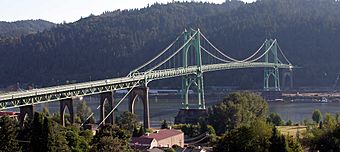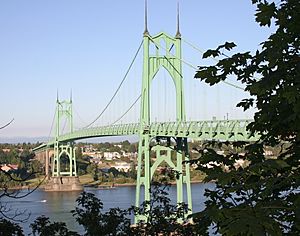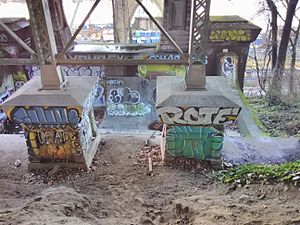St. Johns Bridge facts for kids
Quick facts for kids St. Johns Bridge |
|
|---|---|
 |
|
| Coordinates | 45°35′06″N 122°45′53″W / 45.58508°N 122.76477°W |
| Carries | |
| Crosses | Willamette River |
| Locale | Portland, Oregon (Cathedral Park neighborhood, Northwest Industrial District/Linnton) |
| Maintained by | Oregon Department of Transportation |
| Heritage status | Portland Historic Landmark |
| Characteristics | |
| Design | Suspension bridge, Gothic |
| Total length | 2,067 feet (630 m) |
| Height | 400 feet (120 m) |
| Longest span | 1,207 feet (368 m) |
| Clearance below | 205 feet (62 m) |
| History | |
| Designer | David B. Steinman |
| Opened | June 13, 1931 |
| Lua error in Module:Location_map at line 420: attempt to index field 'wikibase' (a nil value). | |
The St. Johns Bridge is a beautiful steel suspension bridge that crosses the Willamette River in Portland, Oregon. It connects the Cathedral Park neighborhood in North Portland with the Linnton and Northwest Industrial areas in Northwest Portland. This bridge helps people travel by carrying the U.S. Route 30 Bypass. It's special because it's the only suspension bridge in the entire Willamette Valley and one of only three public highway suspension bridges in Oregon.
The main part of the bridge stretches 1,207-foot (368 m) across the river. Its total length is 2,067 feet (630 m). The St. Johns Bridge is the tallest bridge in Portland. It has two huge towers that stand 400-foot-tall (120 m). There is also 205-foot (62 m) of space underneath for boats to pass safely. The nearby park and neighborhood, Cathedral Park, got their name because the bridge's towers look like a Gothic Cathedral.
Contents
Building the St. Johns Bridge
The St. Johns Bridge was designed by a famous engineer named David B. Steinman (1886–1960) and Holton D. Robinson from New York. When it was built, it was the longest suspension bridge of its kind west of the Mississippi River. It's still one of only three major highway suspension bridges in Oregon.
Why Was the Bridge Needed?
Before the bridge, people used a ferry to cross the river. About 1,000 vehicles used this ferry every day. At first, some people in Multnomah County weren't sure about building a bridge. The areas of St. Johns and Linnton were quite far from the city center. Local business owners didn't have much power to convince people.
But supporters worked hard to get the bridge approved. They even put on a fun vaudeville-style show at local halls and schools. Their efforts paid off! In November 1928, voters approved a plan to spend $4.25 million to build the bridge. Engineers first thought about building a different type of bridge called a cantilever bridge. However, they chose a suspension bridge because it would save about $640,000 in building costs.
Construction During Tough Times
Building the bridge started just one month before the Stock Market Crash of 1929. This was a very difficult time for the economy. The bridge project helped many people in the county find jobs during the Great Depression.
Some government officials wanted the bridge painted yellow with black stripes. This was because it was close to the Swan Island Municipal Airport. But county officials waited until St. Patrick's Day in 1931 to announce that the bridge would be painted green.
Opening Day and Special Features
The bridge's official opening was delayed by one month. This was so it could be the main attraction of the 23rd annual Rose Festival. The St. Johns Bridge was officially opened on June 13, 1931. During the ceremony, the bridge engineer, David B. Steinman, said:
A challenge and an opportunity to create a structure of enduring beauty in the God-given wondrous background was offered us when were asked to design the bridge. It is the most beautiful bridge in the world we feel.
The bridge was built very quickly, in just 21 months. It also cost one million dollars less than planned! When it was finished, the St. Johns Bridge had several amazing features:
- It had the highest clearance for boats in the nation.
- It used the longest prefabricated steel cable rope strands.
- It had the tallest steel frame piers made of reinforced concrete.
- It was the first bridge to use special aviation clearance lights on its towers.
- It had the longest suspension span west of Detroit, Michigan.
It was many years later, in 1966, when the Marquam Bridge was built, that Portland got another non-movable bridge.
Keeping the Bridge Strong
By the 1970s, the bridge was starting to show its age. Multnomah County, which was low on money, asked the state to take over its care. At first, the state also didn't have enough funds. But after pressure from local governments, the state government agreed to take over on August 31, 1975. This decision saved the county a lot of money, estimated at $10 million in the first ten years.
Parts of the bridge on the east side were repainted between 1987 and 1994.
Major Renovation Project
In 1999, the Oregon Department of Transportation announced a big project to fix up the bridge. This $27 million renovation started in March 2003 and finished in the fall of 2005. The project included many important updates:
- Replacing the bridge's deck (the road surface).
- Repainting the tall towers.
- Making the main cables waterproof.
- Upgrading the lights on the bridge.
- Making it easier for bikes and people walking to use the bridge.
By November 2004, the cost of the renovation went up to $38 million. This was mainly because almost half of the 210 vertical cables that hold up the bridge needed to be replaced. During the project, the sidewalks on the bridge were closed. The entire bridge was also closed at night and for a whole month at one point. The newly fixed-up bridge was celebrated again on September 17, 2006.
Recent Events and Art
In 2008, a 40-foot-long sculpture was placed at one end of the bridge. It had a music box inside that played a song called Up a Lazy River. This song was popular in 1931, the year the bridge opened.
In July 2015, a group of people connected with Greenpeace protested under the bridge. They climbed down from the bridge to stop a ship called the MSV Fennica from leaving Portland. The ship was going to help Shell Oil Company look for oil in the Chukchi Sea. The protesters stayed there for 40 hours. This caused the ship to turn back after trying to leave. The ship eventually got through after three climbers came down. However, many people in kayaks also tried to slow the ship down.
In March 2019, an unfinished skate park was found hidden under the bridge on the west side. The Oregon Department of Transportation announced that they would remove this unauthorized structure.
Images for kids






